Construction Materials And Technology: UNIT III: Construction Practices & Service Requirements
Stone Masonry
Types, Rubble Masonry, Ashlar Masonry
Stone masonry is used for the construction of walls, columns, lintels, arches, beams, etc., of a building.
STONE MASONRY
Stone
masonry is used for the construction of walls, columns, lintels, arches, beams,
etc., of a building. Stones are abundantly available in nature and when cut and
dressed to proper shapes, they provide an economical material for the
construction of various parts of building. Stone masonry can be classified
according to the thickness of joints, continuity of courses and finish of face.
TYPES OF STONE MASONRY
Stone
masonry is divided into various types as shown below:
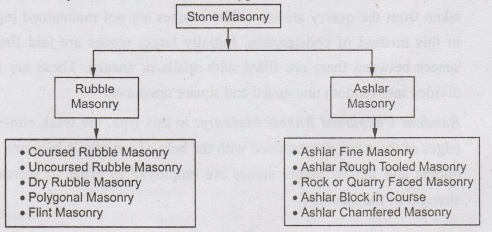
RUBBLE MASONRY
In this type of masonry stones employed are
either undressed or roughly dressed. These masonry constructions do not have a
uniform thickness. The strength of the rubble masonry is dependent on the
quality of mortar used, use of long through stones, and proper filling of
mortar between the stone spaces and joints: Rubble masonry can be again
classified into the following types:
❖ Coursed
Rubble Masonry: In this type of masonry, the stones in a
particular course are of equal heights. The stones hence used possess different
sizes. Also in this type, all the courses do not have same height. This type is
commonly employed in the construction of public buildings, abutments,
residential buildings and piers of ordinary bridges.
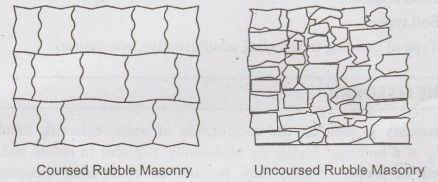
❖ Uncoursed
Rubble Masonry: This type of rubble masonry is the cheapest
and roughest form of stone masonry construction. This masonry use stones of
varied shape and size. The undressed stone blocks which are directly taken from
the quarry are used. The courses are not maintained regularly in this method of
construction. Initially larger stones are laid first. The spaces between them
are filled with spalls or sneeks. These are further divided into random
uncoursed and square uncoursed.
Random Uncoursed Rubble Masonry: In this type, the weak corners and edges of
the stone are removed with the help of a mason's hammer. At the quoins and
jambs, bigger stones are employed in order to increase the strength of the
masonry.

❖ Square Uncoursed Rubble Masonry: In this type, the stones are made roughly
square shape and used in construction. The facing stones are provided a
hammer-dressed finish. Larger stones are used as quoins. Here chips are not
used as bedding.
❖ Dry Rubble Masonry: These are rubble masonry construction
performed without the use of mortar. Small spaces are filled with smaller
stone. pieces. It is used in pitching the earthen dams and the canal slopes.
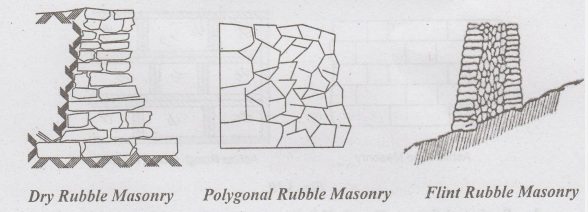
❖ Polygonal
Rubble Masonry: In this type, the stones used for masonry
are roughly shaped into irregular polygons. The stones are then arranged in
such a way that it avoids vertical joints in the face work. Also stone chips
are used to support the stones.
❖ Flint
Rubble Masonry: In areas where flint is available plenty, a
flint rubble masonry is employed. Flints are irregularly shaped nodules of silica.
They are extremely hard but brittle in nature. The thickness of the flint
stones varies from 8 to 15cm. Their length varies from 15 to 30 cm.
ASHLAR MASONRY
Ashlar masonry is constructed using
accurately dressed stones that possess uniform and fine joints. The thickness
of the joints ranges about 3mm which is arranged in various patterns. The size
of the stone blocks must be in proportion with the thickness of the walls. The
various types of ashlar masonry are:
❖ Ashlar
Fine Masonry: In ashlar fine masonry construction, each
stone is cut into uniform size and shape, almost rectangular in shape. This
shape hence provides perfect horizontal and vertical joints with the adjacent
stones. An ashlar fine masonry construction is very costly.
❖ Ashlar
Rough Masonry: This type has stones whose sides are finely
chisel -dressed. The face of the stones is made rough by means of tools. Around
the perimeter of the rough dressed face of each stone, a strip of 25mm width is
provided.
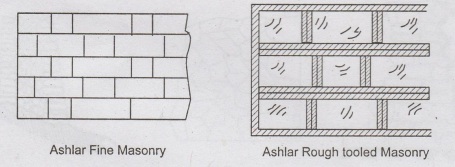
❖ Rock and Quarry Faced: This masonry type has a 25 mm wide strip
made by a chisel placed around the perimeter of every stone. The remaining
portion of the face is left in the same form as it is received.
❖ Ashlar Block in Course Masonry: This type is a combination of ashlar masonry
and rubble masonry. The faces work of the masonry stones is either rough tooled
or hammer dressed stones. The backing of the wall may be done in rubble
masonry.
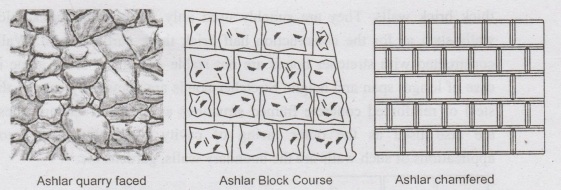
❖ Ashlar Chamfered Masonry: A strip is provided as shown in the figure.
Sides of the stones are chamfered or beveled at an angle of 45 degrees by means
of a chisel at a depth of 25mm.
Construction Materials And Technology: UNIT III: Construction Practices & Service Requirements : Tag: : Types, Rubble Masonry, Ashlar Masonry - Stone Masonry
Related Topics
Related Subjects
Construction Materials and Technology
CE3302 3rd Semester Civil Dept 2021 Regulation | 3rd Semester Civil Dept 2021 Regulation
